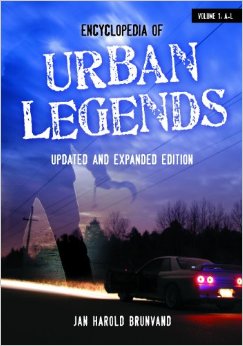Review: Urban Legends July 12, 2015
Author: Beach Combing | in : Contemporary , trackbackJan Harold Brunvand is the Urban Legend man, he has been writing books, since 1981 on modern folklore narratives, those curious stories that get passed from relative stranger to relative stranger or that are discussed earnestly at sleepovers among close friends. Three years ago JHB brought out his most important compendium yet, The Encyclopedia of Urban Legends: the updated and expanded version. It is a two volume set running to 782 pages that costs 180 dollars (we’ll come back to the price below). There are scores of voces either related to individual stories ‘shooting the bull’, ‘the vanishing hitchhiker’ or to themes ‘Revenge in Urban Legends’.
What is an urban legend? Well, after reading the two volumes Beach is more confused than ever probably because he has some sense of the complexity of the matter. JHB, though, for what it is worth, defines these urban legends as ‘all those bizarre, whimsical, 99 percent apocryphal, yet believable stories that are ‘too good to be true’. They are too odd, too coincidental, and too neatly plotted to be accepted as literal truth in every place where they are told and localized.’ Yes, you know, the high hippy who puts the baby in the oven, the woman who accidentally has sex with her husband’s best friend, the boyfriend who sits on his girlfriend’s dog…
All these qualify and all these stories seem to rely on that crucial word ‘truth’. They are told as if they happened, and the story’s enjoyment seems to depend on them being believed or being half believed: this means that they are repeatedly said to have happened to a friend’s aunt’s lover or a lover’s aunt’s friend. JHB, like most folklorists, is very accepting of the wiles of tradition, but there are a few too many entries in the Encyclopedia where he relishes telling someone that the story in question didn’t actually happen, what might be called ‘the you are on Candid Camera’ moment. Beach was reminded of atheists being compared (by a theologian) to protesters handing out fliers to cinema-goers protesting that this or that film was a fiction.
A particularly disturbing brand of urban legend are the emails and xerox warnings passed out claiming that, for example, this or that gang are using this or that trick to rape women and chop their legs off (really!). It is easy to understand why a certain type of person (Beach has a cousin…) might pass these on but why write them? They serve, for the most part, no obvious end for good or, even, really for evil. There is a striking example in the book of ‘the Veterans Insurance Claim’ where a letter claims that all WW2 veterans have to write to a government address to get some money owing to them. Thousands of letters were sent… Why do this to the greatest generation?
The book is clearly intended for academic libraries (in fact Beach’s copy had been removed from a Michigan university library, after just two years!) But, this being JHB, it is written in such a spritely and enjoyable manner that anyone with the slightest interest in folklore or story-telling would enjoy it: Mrs B had never heard of most of the stories and has tolerated two or three an evening. This makes the price-tag of 180 dollars particularly troubling: and don’t even let’s get started on 160 dollars for the kindle version. Still if you have a hundred dollars and you live near Michigan you might, sooner or later, be able to pick up a second-hand copy: and this book is definitely worth going without tacos and ginger beer for a month.
Beach should finish by saying that he is fascinated by the way that in advanced middle ages he still believes things that he heard as a child or young man because (back then) he trusted some authority. There follow a list of urban legends that, until reading JHB’s book, Beach was not aware were urban legends. He is now having to reassess several foundation pillars of his life.
Stove gas being used to knock out babies by harassed nannies. Source: the BBC. Age 25.
Bungled cat rescue. Source: stepfather who worked for the BBC. Age 10.
1 Word Exam Answer. Source: a psychologist in Dublin (who claimed it happened to her). Age 24.
Death elevator dream story. Source: a children’s book. Age 10.
ATM machine thieves who photograph your card. Source: idiot brother-in-law. Age 30.
Contaminated blankets being given to Indian tribes. Source: various history books. Age 15+
Razor blade sabotage. Source: boardgame. Age 10.
Stolen speedtrap. Source: BBC radio program. Age 20.
A suppressed invention. Source: stepfather. Age 10.
Superheroes sexual jinks. Source: an uncle. Age 10.
Of course, some of the stories might be true, as JHB points out: there are a couple of urban legends that demonstrably took place in ‘real time’. A particularly delicious passage summarized by JHB is the character from an Ian McEwan novel who lives out an urban legend and then meets a folklorist who solemnly tells him that it never happened.



